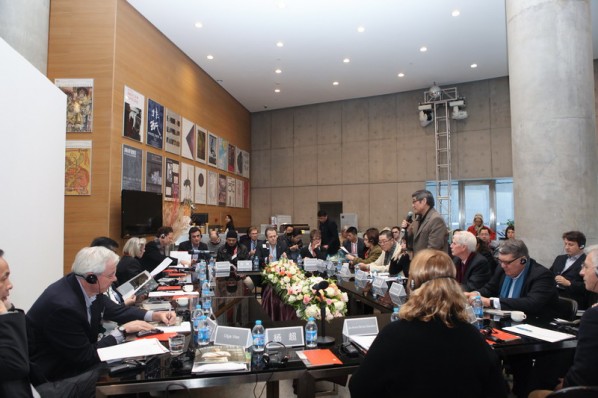
Sino-American Culture and Art Forum: "The Summit of Museum Directors" was held in Beijing at the National Museum of China at 9:00am on November 16, 2012, and lasted for two days. The 2nd section discussion was held at the cafe of the CAFA Art Museum on November 17, and the delegation visited some selected galleries in the 798 art district led by Philip Tinari, Director of UCCA in the afternoon, and then they participated in the reception hosted by Christie’s and enjoyed concerts in the Concert Hall of the Central Conservatory of Music in the evening.
There were 15 directors of art museums from the US and 16 directors of art museums from China participating the Summit Dialogue and the in-depth discussions, the directors from US included Jennifer Russell, Deputy Director of the Exhibition Department of the Metropolitan Museum of Art in New York, Adam D. Weinberg, Alice Pratt Brown Director of Whitney Museum of American Art, Jay Xu, Director of the Asian Art Museum of San Francisco, etc., and directors from China including Wang Huangsheng, Director of the CAFA Art Museum, Lv Zhangshen, Director of the National Museum of China, Chen Jianning and Shao Shan, Deputy Directors of Guangdong Museum of Art, Fan Di’an, Director of National Art Museum of China, Pan Gongkai, President of CAFA, etc.
The meeting was jointly presided over by Xia Wei, Arthur Ross Dean from the Asia Society Center on Sino-American Relations in New York, US, Zhao Yingsi, Director of the Asia Society and Museum, Li Jianping, Vice President of the Chinese People’s Association for Friendship with Foreign Countries, Lv Zhangshen, Director of the National Museum of China, and in the opening remarks they introduced the history of the museums’ development in the two countries, the history of museums’ exchanges, and the role of the museums’ exchanges along with the culture exchanges between China and the US..
[gallery link="file" orderby="title"]
There were three major issues discussed in the first section of the meeting held at the National Museum of China: firstly, the management and operation of the museum; secondly, the social responsibility of the museum; thirdly, the international cultural exchange of the museum. At the beginning, Wang Huangsheng, Director of the CAFA Art Museum, made a speech, initially introducing the history of the CAFA Art Museum as well as the construction of the new museum, and he pointed out the features of operating the museum as part of the academy: firstly, the implementation of the concept of “independent planning,” such as building a communication platform for contemporary art through Super-organism CAFAM Biennale in CAFAM, as well as the academic exhibition “Self-Image: Female Art in China from 1920 to 2010”, etc., and there was a research exhibition of Beuys which was recently planned by CAFA Art Museum, studying the significant impact on Chinese contemporary art by Beuys from the perspective of Chinese scholars; secondly, in the international co-operation, the CAFA Art Museum actively cooperated with some foreign museums such as the Louvre and Uffici, with an open attitude keen on learning, because there were still some shortcomings of the operation and management of domestic art museums compared to the Western museums, we could learn and improve with the future cooperation of foreign art museums; thirdly, he emphasized on the ethical culture and innovation in the public space. He hoped to build a more open and interactive art museum, for which, “College Forum of Art Museum” and the publication “the College and the Art Museum” have been established; additionally, regarding the operation and sponsorship, CAFA Art Museum received support from the government and the CAFA for being a part of the academy, on the other hand, it obtained sponsorship from the community on the principle of sharing resources.
Directors from China and US had discussions and dialogues on the issues of opportunities, challenges and problems that their own art museum had encountered, and their dialogues focused on the audiences visit museums: how to attract audiences to an art museum? Whether the quality of an art museum was evaluated by the number of the audiences? What could an audience obtain by visiting a museum? Directors expressed their point of views on this issue.
At the second meeting at the CAFA Art Museum, directors and related workers from China and US had lively speeches on the issues of what kind of support they wanted, what kinds of planning for a longer–term cultural exchange. On the issue of the cooperation between art colleges and art museums, Jock Reynolds, Director of the Art Gallery of Yale University, mentioned in his speech, many museums in the US would provide scholarships for students, and during this meeting, he believed that the barrier of different languages was still a problem, and he wished to establish an exchange program for long-term residency to solve it, as well as further understanding the essence of both institutions in the long-term observation process. On the other hand, Adam D. Weinberg, Alice Pratt Brown Director of Whitney Museum of American Art, USA, believed that a three-day intensive visit would be more effective than a three-month residency project. On the curatorial work of museum and art museum, Jay Xu, Director of Asian Art Museum in San Francisco, had proposed some issues concerning the curatorial work of ancient and traditional art, which has generated a responsive chord in the participants: contemporary art was almost exclusively the focus in today’s curator training, while curators of traditional art are rare to foster, and he throught, to solve this problem, directors from the two countries should communicate with each other and discuss for countermeasures. Thereafter all the directors had a discussion on how to get further support to art and art museums from Chinese enterprises, learning from the experience of the U.S. Finally, directors appreciated “Reconstruction of the Works” achievement cooperated by Pan Gongkai, President of the CAFA Art Museum, and Cliff Ross, an American photographer.
Pan Gaojie/CAFA ART INFO
Photo/ CAFA Art Museum
Courtesy CAFA ART INFO




























